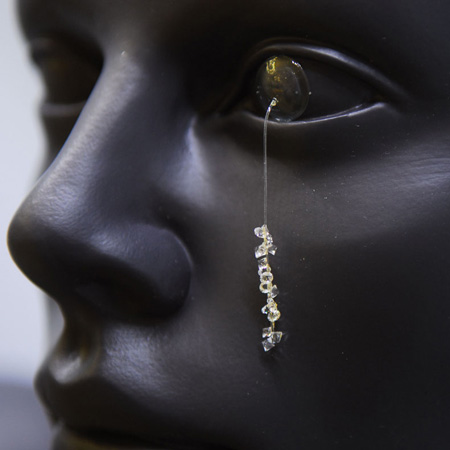
Natural History at Selfridges
The Wonder Room at Selfridges department store in London is hosting an exhibition of jewellery influenced by the natural world, described as "a heady mix of taxidermy, genetic-engineered jewellery and natural pearls".
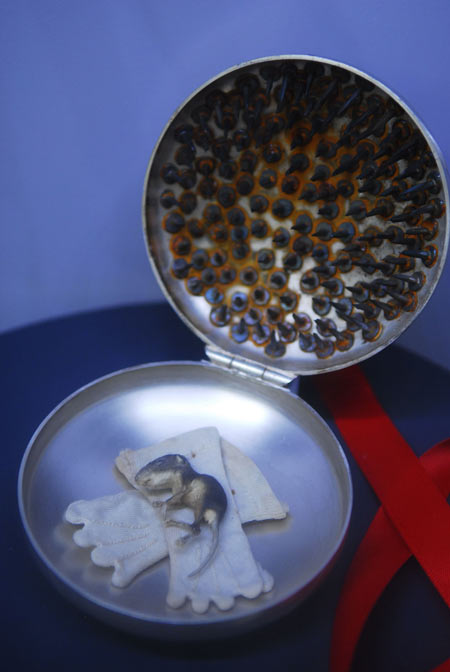
Curated by Jane Withers and featuring work from young designers Melanie Georgacopoulos, Tobie Kerridge, Kelly McCallum (above) and Eric Klarenbeek (top image), exhibits include a ring grown from human cells and a contact lens pendant.
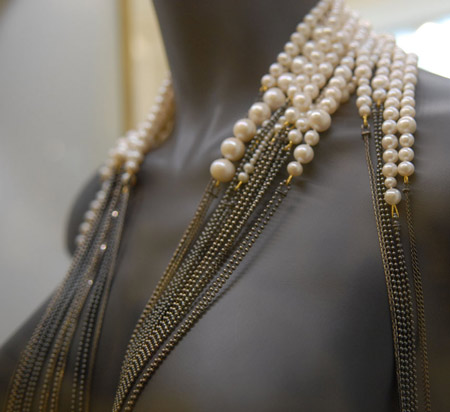
The exhibition will be open during store hours and will continue until 7 September. Above: Pearl Necklace by Melanie Georgacopolous.
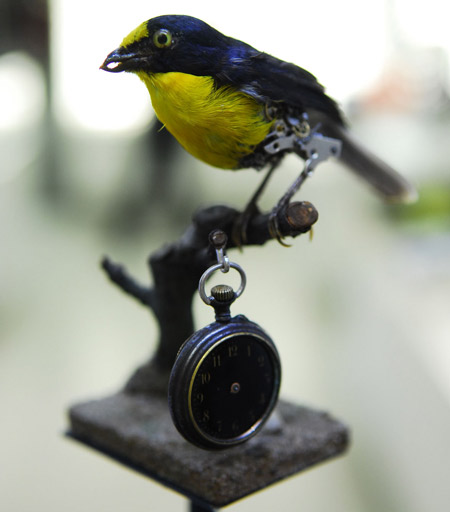
Above: Kelly McCallum. See our earlier story for more work by Kelly McCallum.
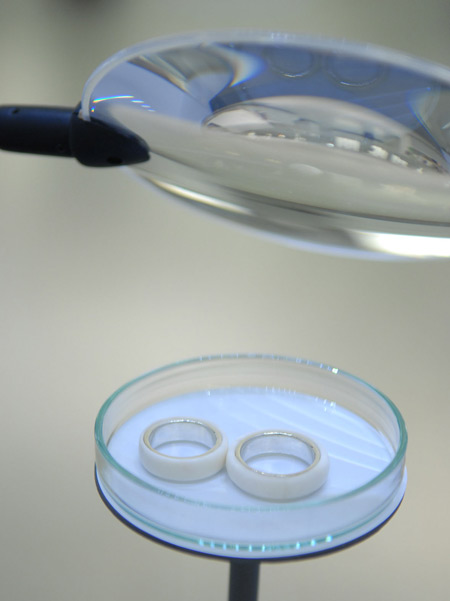
Above: Biojewellery by Tobie Kerridge
The following is from Selfridges:
--
Selfridges shows a unique take on ‘Natural History’
A heady mix of taxidermy, genetic-engineered jewellery and natural pearls generates a most unusual exhibition.
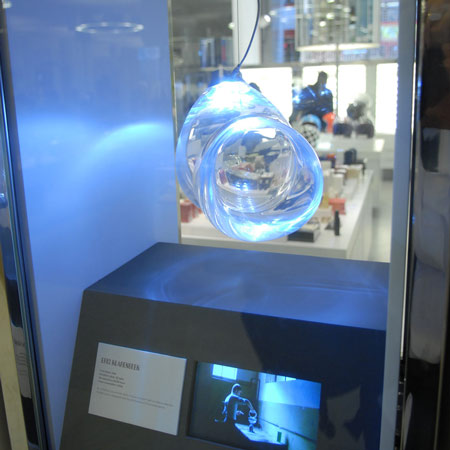
Above: The Lucid Dream by Eric Klarenbeek
Selfridges opens a new bijou exhibition called Natural History within The Wonder Wall, the place in the store dedicated to the presentation of private collections of celebrities and extremely unusual products.
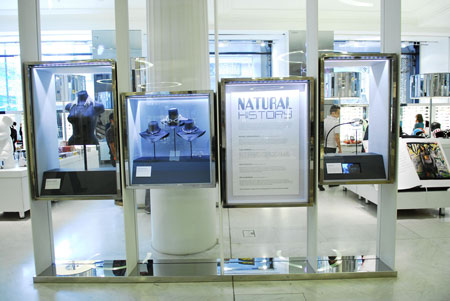
At the dawn of the 21st century our relation to the natural world is being challenged on every level from genetic engineering to plastic surgery.
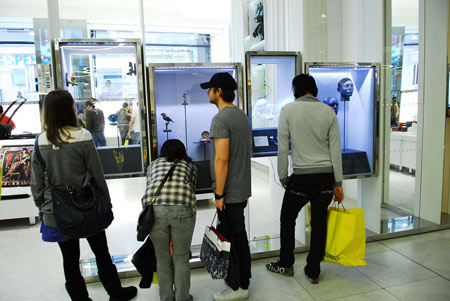
Natural History brings together one-off pieces by four young designers linked together by their drive to explore the contemporary nature of wonder but with very different takes on nature and the boundaries between nature and artifice: from biojewellery grown from donated bone tissue cells to jewellery that mimics body parts; from a fascination with Victorian taxidermy to a fresh look at that most traditional natural wonder, the pearl.
Artists and the work on display
Melanie Georgacopolous
Associated with historic grandeur and glamour as well as twinset and pearl conventionality, the pearl necklace is ripe for reinvention. Exploring beyond surface beauty, Melanie Georgacopoulos reveals the form, material and magical properties of the pearls themselves.
Her pieces for the Natural History exhibition are both simple and surprising – for instance showing how pearls can be recreated marrying up white and black halves into striking combinations that never feel man-made. The work is available for sale with prices ranging from £1,300 to £5,000.
Melanie studied sculpture at Edinburgh College of Art before pursuing a career in jewellery. She recently graduated with an MA in jewellery and metalwork from the Royal College of Art. Her art background and diverse interests have enabled her to undertake various jewellery projects, from creating sculptural pieces for the catwalk to designing commercial lines.
Tobie Kerridge
As the shifting boundaries of medicine raise ethical questions, biojewellery explores the potential of growing jewellery from human cells. The work on display originated from a couple’s wish to own a unique piece of jewellery that would epitomise their lover for each other. The couple donated cells during a routine wisdom tooth extraction. These were seeded onto a ring shaped scaffold that encourages the cells to divide and grow rapidly. The scaffolds were incubated in a cell culture medium for six weeks to form new bone. This was combined with precious metals to make a ring for each partner with the tissue of the other partner. The inscription reads ‘totus tuus, ad extremum’, ‘yours, to the extreme’.
Tobie graduated in Interaction Design from the RCA in 2003, and currently works as a research fellow in the design department at Goldsmiths College. Biojewellery was launched in 2004 as a collaborative project run by Kerridge, his RCA research colleague Nikki Stott, and Ian Thompson, a bioengineer at King’s College, London, and funded by the Engineering and Physical Sciences Research Council.
Kelly McCallum
McCallum is interested in the stories behind things and how they age and decay, are preserved or forgotten. Treasures and keepsakes, from Victorian taxidermy to Japanese toys, are adapted with a jeweller’s attention to detail and worked into new scenarios that celebrate the interplay between life and death. The pieces on show from Kelly’s collection are a mix of jewellery available for sale from £300 to £600 and some enhanced bird taxidermy curated exclusively for the exhibition.
Kelly graduated from the Royal College of Art in goldsmithing in 2006. She applies the minutiae of a jeweller’s method and vision to creating both wearable and sculptural pieces employing Victorian taxidermy, insects, precious metals, and other treasures, as well as curiosities collected from around the world.
Eric Klarenbeek
Klarenbeek explores the potential of jewellery as body parts. Intrigued by artificial objects that are always with us and almost become part of us, Klarenbeek fuses the real and the unreal, blurring the transition between what we are and how we might optimise or improve our being. The Eye Jewellery Project perfectly epitomises this approach with its contact lens decorated by a medical wire and crystals made to imitate tears running on a cheek, but permanently. Elsewhere Lucid Dreams recreates the dreamy reality of a soap bubble without its ephemeral nature as it is built from clear handblown glass and LED lights with a life expectancy of over 50,000 hours.
Eric graduated in 2003 from The Design Academy, Eindhoven. Since then he has designed for Davidoff, Droog Design, Moooi, Jurgen Bey, the city of Amsterdam and the province Gelderland. He teaches at the Art Academy Enschede (AKI). Projects such as The Floating Light, Poekie and The Eye Jewellery Project have been featured in the media worldwide.